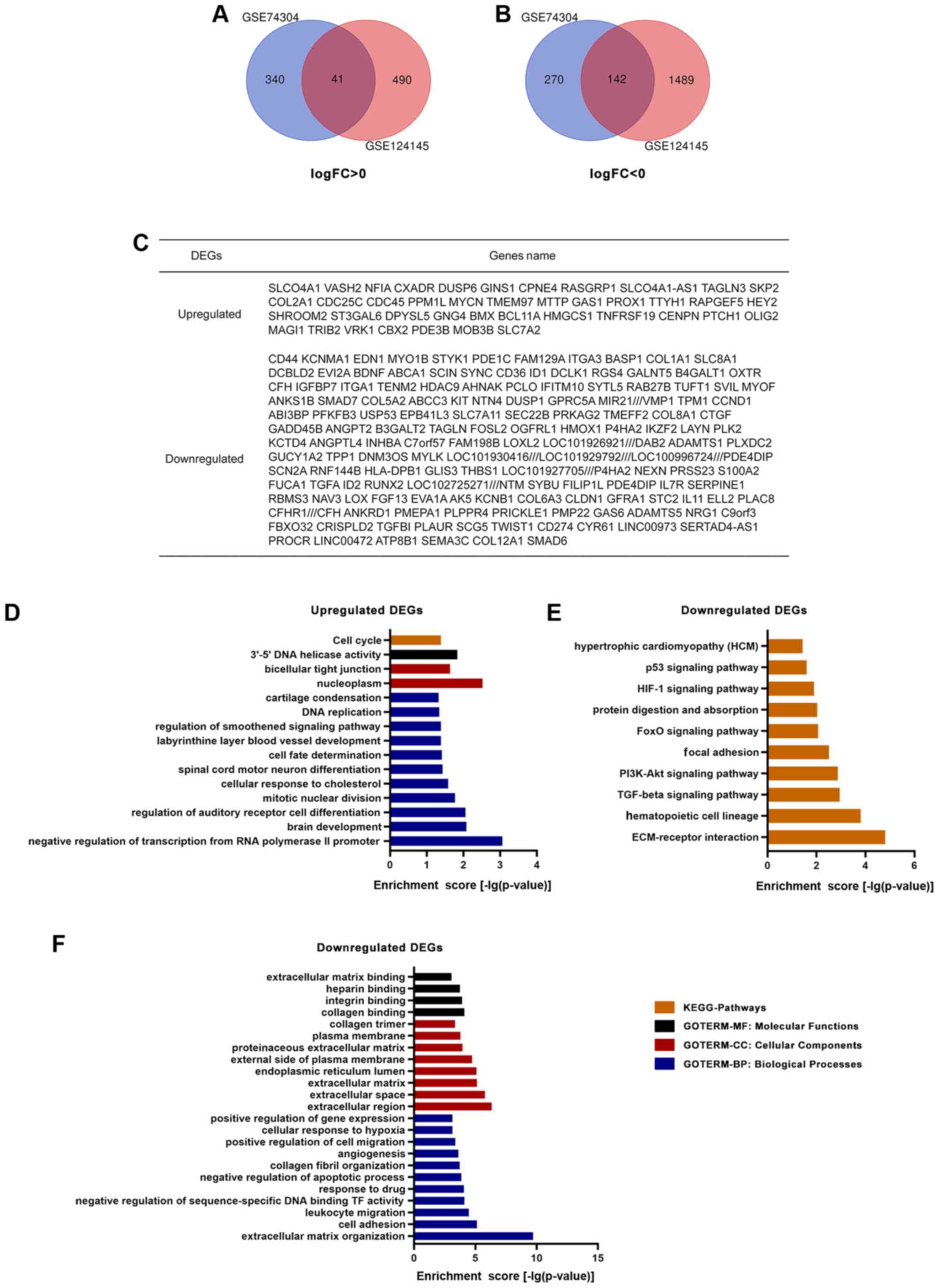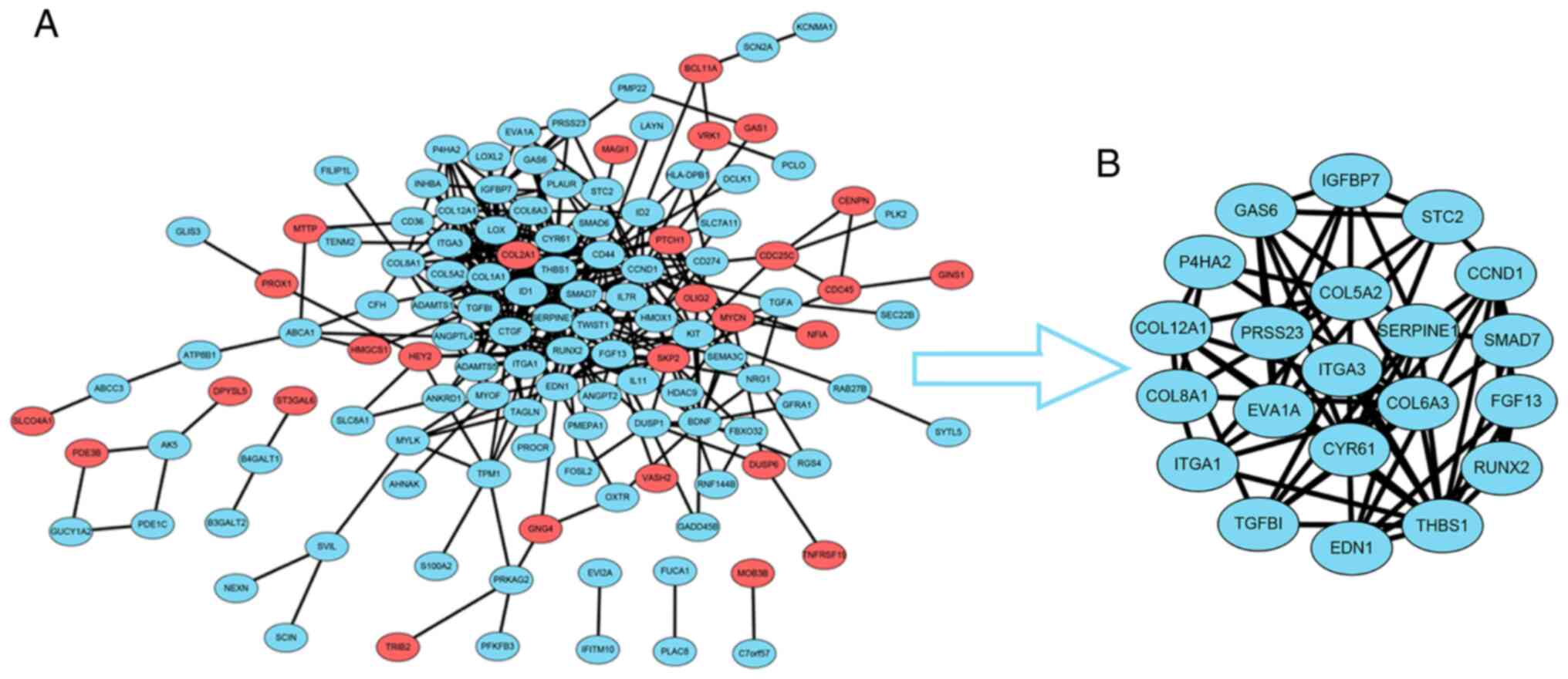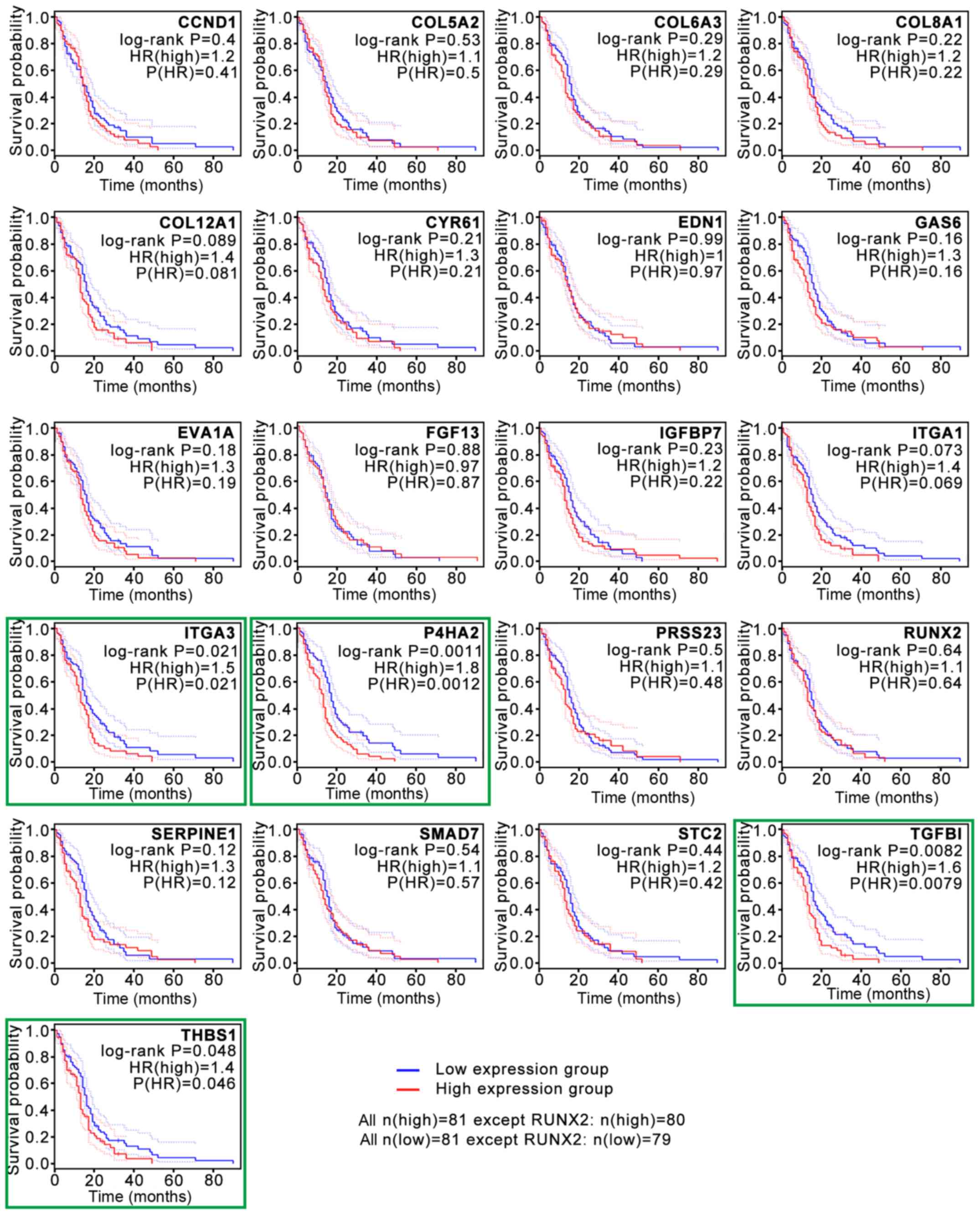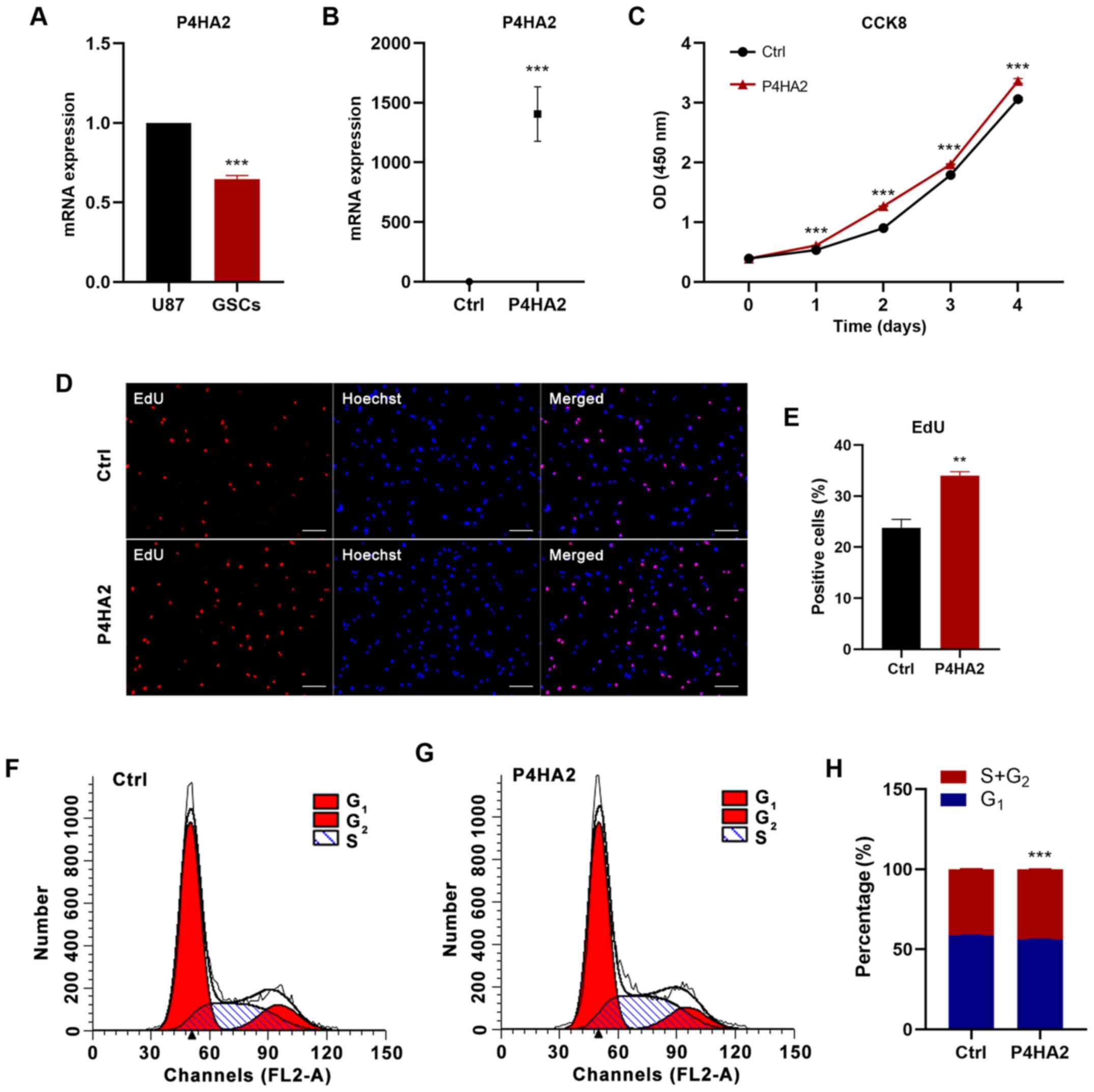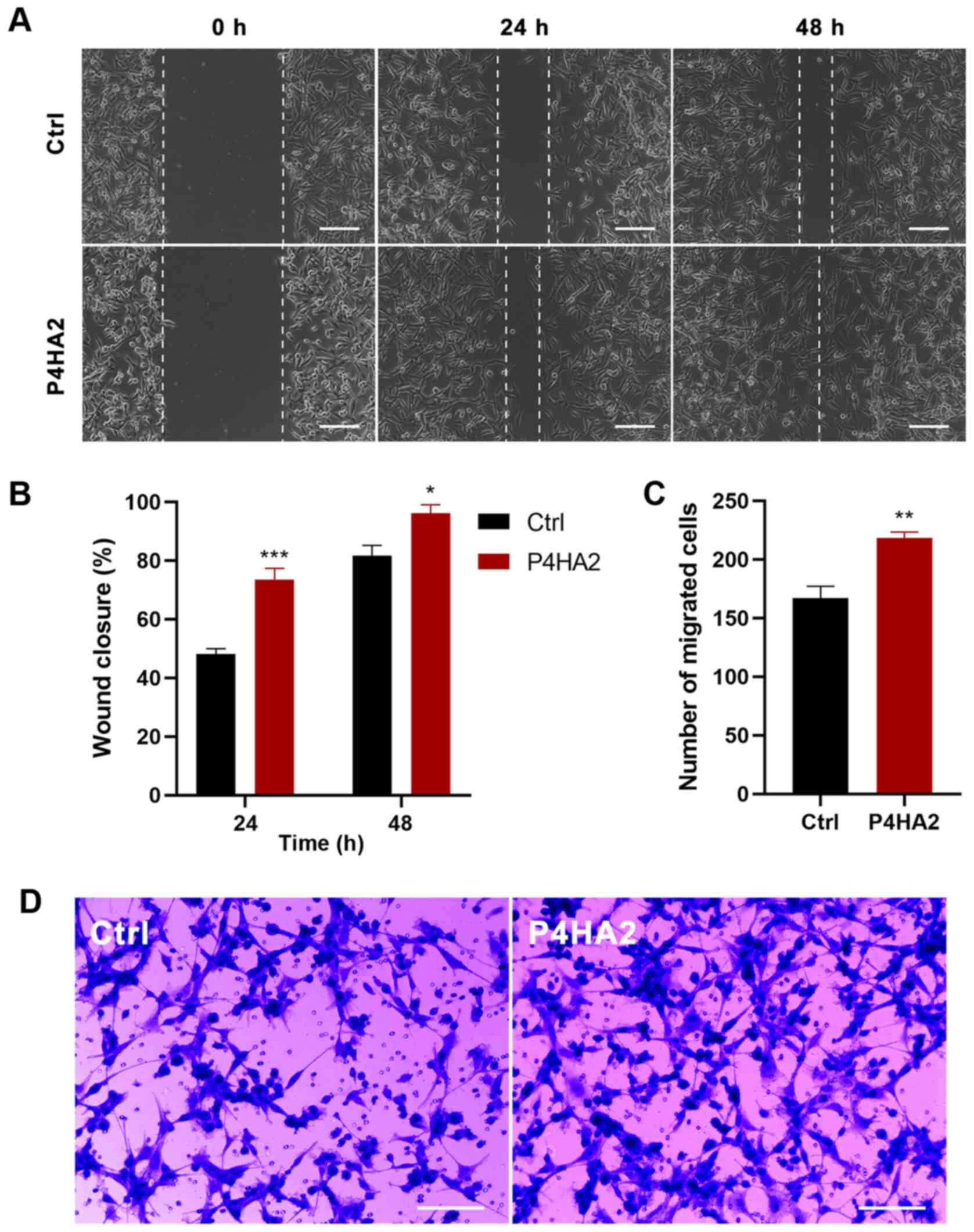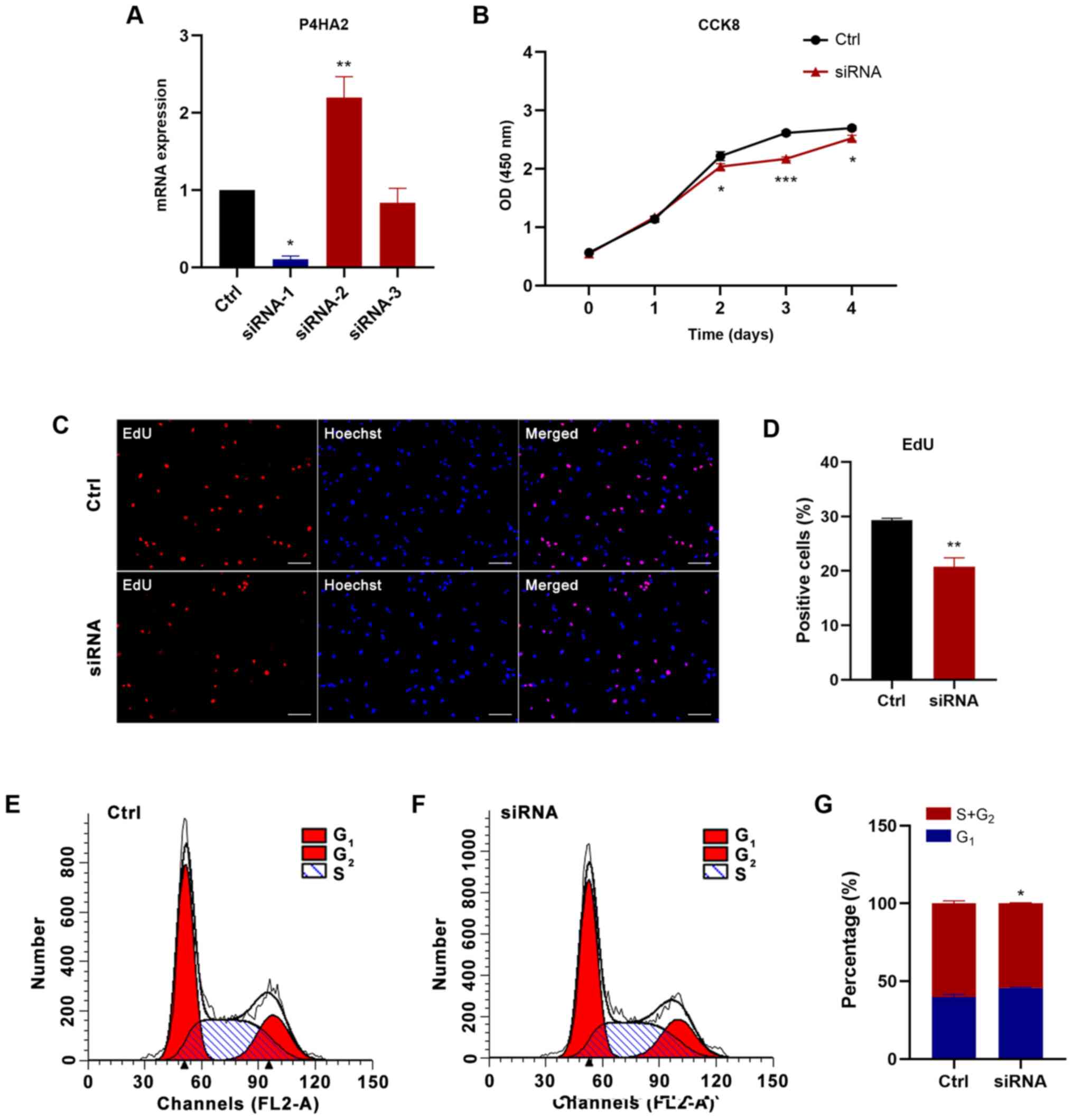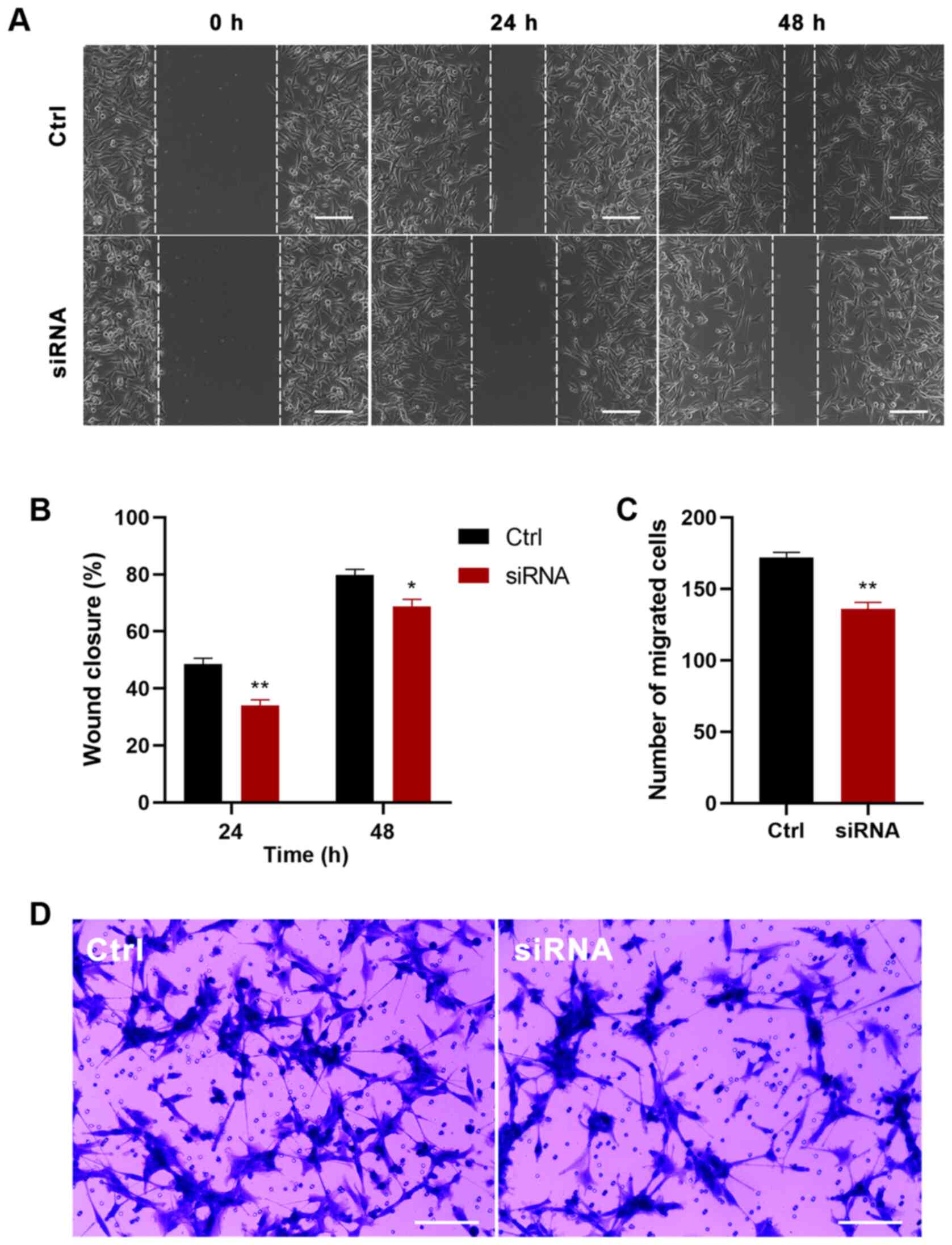|
1
|
Camelo-Piragua S and Kesari S: Further
understanding of the pathology of glioma: Implications for the
clinic. Expert Rev Neurother. 16:1055–1065. 2016. View Article : Google Scholar : PubMed/NCBI
|
|
2
|
Stupp R, Hegi ME, Mason WP, van den Bent
MJ, Taphoorn MJ, Janzer RC, Ludwin SK, Allgeier A, Fisher B,
Belanger K, et al European Organisation for Research and Treatment
of Cancer Brain Tumour and Radiation Oncology Groups; National
Cancer Institute of Canada Clinical Trials Group, : Effects of
radiotherapy with concomitant and adjuvant temozolomide versus
radiotherapy alone on survival in glioblastoma in a randomised
phase III study: 5-year analysis of the EORTC-NCIC trial. Lancet
Oncol. 10:459–466. 2009. View Article : Google Scholar : PubMed/NCBI
|
|
3
|
Davis ME: Glioblastoma: Overview of
disease and treatment. Clin J Oncol Nurs. 20 (Suppl 5):S2–S8. 2016.
View Article : Google Scholar : PubMed/NCBI
|
|
4
|
De Sousa E, Melo F, Vermeulen L, Fessler E
and Medema JP: Cancer heterogeneity - a multifaceted view. EMBO
Rep. 14:686–695. 2013. View Article : Google Scholar : PubMed/NCBI
|
|
5
|
Yoshida GJ and Saya H: Therapeutic
strategies targeting cancer stem cells. Cancer Sci. 107:5–11. 2016.
View Article : Google Scholar : PubMed/NCBI
|
|
6
|
Lathia JD, Mack SC, Mulkearns-Hubert EE,
Valentim CL and Rich JN: Cancer stem cells in glioblastoma. Genes
Dev. 29:1203–1217. 2015. View Article : Google Scholar : PubMed/NCBI
|
|
7
|
Morgan MA and Canman CE: Replication
stress: An Achilles heel of glioma cancer stem-like cells. Cancer
Res. 78:6713–6716. 2018. View Article : Google Scholar : PubMed/NCBI
|
|
8
|
Ludwig K and Kornblum HI: Molecular
markers in glioma. J Neurooncol. 134:505–512. 2017. View Article : Google Scholar : PubMed/NCBI
|
|
9
|
Ouchi R, Okabe S, Migita T, Nakano I and
Seimiya H: Senescence from glioma stem cell differentiation
promotes tumor growth. Biochem Biophys Res Commun. 470:275–281.
2016. View Article : Google Scholar : PubMed/NCBI
|
|
10
|
Sakamoto D, Takagi T, Fujita M, Omura S,
Yoshida Y, Iida T and Yoshimura S: Basic gene expression
characteristics of glioma stem cells and human glioblastoma.
Anticancer Res. 39:597–607. 2019. View Article : Google Scholar : PubMed/NCBI
|
|
11
|
Tang Z, Li C, Kang B, Gao G, Li C and
Zhang Z: GEPIA: A web server for cancer and normal gene expression
profiling and interactive analyses. Nucleic Acids Res. 45:W98–W102.
2017. View Article : Google Scholar : PubMed/NCBI
|
|
12
|
Nakano I, Joshi K, Visnyei K, Hu B,
Watanabe M, Lam D, Wexler E, Saigusa K, Nakamura Y, Laks DR, et al:
Siomycin A targets brain tumor stem cells partially through a
MELK-mediated pathway. Neuro-oncol. 13:622–634. 2011. View Article : Google Scholar : PubMed/NCBI
|
|
13
|
Nakano I, Masterman-Smith M, Saigusa K,
Paucar AA, Horvath S, Shoemaker L, Watanabe M, Negro A, Bajpai R,
Howes A, et al: Maternal embryonic leucine zipper kinase is a key
regulator of the proliferation of malignant brain tumors, including
brain tumor stem cells. J Neurosci Res. 86:48–60. 2008. View Article : Google Scholar : PubMed/NCBI
|
|
14
|
Livak KJ and Schmittgen TD: Analysis of
relative gene expression data using real-time quantitative PCR and
the 2(-Delta Delta C(T)) method. Methods. 25:402–408. 2001.
View Article : Google Scholar : PubMed/NCBI
|
|
15
|
Xu L, Wang Y, Liu J, Zhu W and Mao S:
Morphological adaptation of sheep's rumen epithelium to high-grain
diet entails alteration in the expression of genes involved in cell
cycle regulation, cell proliferation and apoptosis. J Anim Sci
Biotechnol. 9:322018. View Article : Google Scholar : PubMed/NCBI
|
|
16
|
Luo Y, El Agha E, Turcatel G, Chen H, Chiu
J, Warburton D, Bellusci S, Qian BP, Menke DB and Shi W:
Mesenchymal adenomatous polyposis coli plays critical and diverse
roles in regulating lung development. BMC Biol. 13:422015.
View Article : Google Scholar : PubMed/NCBI
|
|
17
|
Liu W, Hahn H, Odze RD and Goyal RK:
Metaplastic esophageal columnar epithelium without goblet cells
shows DNA content abnormalities similar to goblet cell-containing
epithelium. Am J Gastroenterol. 104:816–824. 2009. View Article : Google Scholar : PubMed/NCBI
|
|
18
|
Wesseling P and Capper D: WHO 2016
Classification of gliomas. Neuropathol Appl Neurobiol. 44:139–150.
2018. View Article : Google Scholar : PubMed/NCBI
|
|
19
|
Chen R, Smith-Cohn M, Cohen AL and Colman
H: Glioma subclassifications and their clinical significance.
Neurotherapeutics. 14:284–297. 2017. View Article : Google Scholar : PubMed/NCBI
|
|
20
|
Hatzimichael E, Lo Nigro C, Lattanzio L,
Syed N, Shah R, Dasoula A, Janczar K, Vivenza D, Monteverde M,
Merlano M, et al: The collagen prolyl hydroxylases are novel
transcriptionally silenced genes in lymphoma. Br J Cancer.
107:1423–1432. 2012. View Article : Google Scholar : PubMed/NCBI
|
|
21
|
Aro E, Salo AM, Khatri R, Finnilä M,
Miinalainen I, Sormunen R, Pakkanen O, Holster T, Soininen R, Prein
C, et al: Severe extracellular matrix abnormalities and
chondrodysplasia in mice lacking collagen prolyl 4-hydroxylase
isoenzyme II in combination with a reduced amount of isoenzyme I. J
Biol Chem. 290:16964–16978. 2015. View Article : Google Scholar : PubMed/NCBI
|
|
22
|
Martini D, Giannaccini M, Guadagni V,
Marracci S, Giudetti G and Andreazzoli M: Comparative analysis of
p4ha1 and p4ha2 expression during Xenopus laevis development. Int J
Dev Biol. 63:311–316. 2019. View Article : Google Scholar : PubMed/NCBI
|
|
23
|
Atkinson A, Renziehausen A, Wang H, Lo
Nigro C, Lattanzio L, Merlano M, Rao B, Weir L, Evans A, Matin R,
et al: Collagen prolyl hydroxylases are bifunctional growth
regulators in melanoma. J Invest Dermatol. 139:1118–1126. 2019.
View Article : Google Scholar : PubMed/NCBI
|
|
24
|
Nokelainen M, Nissi R, Kukkola L,
Helaakoski T and Myllyharju J: Characterization of the human and
mouse genes for the alpha subunit of type II prolyl 4-hydroxylase.
Identification of a previously unknown alternatively spliced exon
and its expression in various tissues. Eur J Biochem.
268:5300–5309. 2001. View Article : Google Scholar : PubMed/NCBI
|
|
25
|
Shi R, Gao S, Smith AH, Li H, Shao M,
Shangguan J, Zhang J, Xu J, Ye J, Graham LM, et al:
Superoxide-induced Type I collagen secretion depends on prolyl
4-hydroxylases. Biochem Biophys Res Commun. 529:1011–1017. 2020.
View Article : Google Scholar : PubMed/NCBI
|
|
26
|
Cao Y, Han Q, Li J, Jia Y, Zhang R and Shi
H: P4HA2 contributes to cervical cancer progression via inducing
epithelial-mesenchymal transition. J Cancer. 11:2788–2799. 2020.
View Article : Google Scholar : PubMed/NCBI
|
|
27
|
Wang T, Fu X, Jin T, Zhang L, Liu B, Wu Y,
Xu F, Wang X, Ye K, Zhang W, et al: Aspirin targets P4HA2 through
inhibiting NF-κB and LMCD1-AS1/let-7g to inhibit tumour growth and
collagen deposition in hepatocellular carcinoma. EBioMedicine.
45:168–180. 2019. View Article : Google Scholar : PubMed/NCBI
|
|
28
|
Wang C, Saar V, Leung KL, Chen L and Wong
G: Human amyloid β peptide and tau co-expression impairs behavior
and causes specific gene expression changes in Caenorhabditis
elegans. Neurobiol Dis. 109:88–101. 2018. View Article : Google Scholar : PubMed/NCBI
|
|
29
|
Napolitano F, Di Iorio V, Testa F, Tirozzi
A, Reccia MG, Lombardi L, Farina O, Simonelli F, Gianfrancesco F,
Di Iorio G, et al: Autosomal-dominant myopia associated to a novel
P4HA2 missense variant and defective collagen hydroxylation. Clin
Genet. 93:982–991. 2018. View Article : Google Scholar : PubMed/NCBI
|
|
30
|
Guo H, Tong P, Liu Y, Xia L, Wang T, Tian
Q, Li Y, Hu Y, Zheng Y, Jin X, et al: Mutations of P4HA2 encoding
prolyl 4-hydroxylase 2 are associated with nonsyndromic high
myopia. Genet Med. 17:300–306. 2015. View Article : Google Scholar : PubMed/NCBI
|
|
31
|
Napolitano F, Di Iorio V, Di Iorio G,
Melone MA, Gianfrancesco F, Simonelli F, Esposito T, Testa F and
Sampaolo S: Early posterior vitreous detachment is associated with
LAMA5 dominant mutation. Ophthalmic Genet. 40:39–42. 2019.
View Article : Google Scholar : PubMed/NCBI
|
|
32
|
Cai XB, Zheng YH, Chen DF, Zhou FY, Xia
LQ, Wen XR, Yuan YM, Han F, Piao SY, Zhuang W, et al: Expanding the
phenotypic and genotypic landscape of nonsyndromic high myopia: A
cross-sectional study in 731 chinese patients. Invest Ophthalmol
Vis Sci. 60:4052–4062. 2019. View Article : Google Scholar : PubMed/NCBI
|
|
33
|
Feng GX, Li J, Yang Z, Zhang SQ, Liu YX,
Zhang WY, Ye LH and Zhang XD: Hepatitis B virus X protein promotes
the development of liver fibrosis and hepatoma through
downregulation of miR-30e targeting P4HA2 mRNA. Oncogene.
36:6895–6905. 2017. View Article : Google Scholar : PubMed/NCBI
|
|
34
|
Zhang T, Piao HY, Guo S, Zhao Y, Wang Y,
Zheng ZC and Zhang J: LncRNA PCGEM1 enhances metastasis and gastric
cancer invasion through targeting of miR-129-5p to regulate P4HA2
expression. Exp Mol Pathol. 116:1044872020. View Article : Google Scholar : PubMed/NCBI
|
|
35
|
Pankova D, Jiang Y, Chatzifrangkeskou M,
Vendrell I, Buzzelli J, Ryan A, Brown C and O'Neill E: RASSF1A
controls tissue stiffness and cancer stem-like cells in lung
adenocarcinoma. EMBO J. 38:e1005322019. View Article : Google Scholar : PubMed/NCBI
|
|
36
|
Toss MS, Miligy IM, Gorringe KL, AlKawaz
A, Khout H, Ellis IO, Green AR and Rakha EA: Prolyl-4-hydroxylase α
subunit 2 (P4HA2) expression is a predictor of poor outcome in
breast ductal carcinoma in situ (DCIS). Br J Cancer. 119:1518–1526.
2018. View Article : Google Scholar : PubMed/NCBI
|
|
37
|
Xiong G, Deng L, Zhu J, Rychahou PG and Xu
R: Prolyl-4-hydroxylase α subunit 2 promotes breast cancer
progression and metastasis by regulating collagen deposition. BMC
Cancer. 14:12014. View Article : Google Scholar : PubMed/NCBI
|
|
38
|
Gilkes DM, Bajpai S, Chaturvedi P, Wirtz D
and Semenza GL: Hypoxia-inducible factor 1 (HIF-1) promotes
extracellular matrix remodeling under hypoxic conditions by
inducing P4HA1, P4HA2, and PLOD2 expression in fibroblasts. J Biol
Chem. 288:10819–10829. 2013. View Article : Google Scholar : PubMed/NCBI
|
|
39
|
Hu D, Ansari D, Pawłowski K, Zhou Q, Sasor
A, Welinder C, Kristl T, Bauden M, Rezeli M, Jiang Y, et al:
Proteomic analyses identify prognostic biomarkers for pancreatic
ductal adenocarcinoma. Oncotarget. 9:9789–9807. 2018. View Article : Google Scholar : PubMed/NCBI
|
|
40
|
Li Q, Wang Q, Zhang Q and Zhang J and
Zhang J: Collagen prolyl 4-hydroxylase 2 predicts worse prognosis
and promotes glycolysis in cervical cancer. Am J Transl Res.
11:6938–6951. 2019.PubMed/NCBI
|
|
41
|
Chang KP, Yu JS, Chien KY, Lee CW, Liang
Y, Liao CT, Yen TC, Lee LY, Huang LL, Liu SC, et al: Identification
of PRDX4 and P4HA2 as metastasis-associated proteins in oral cavity
squamous cell carcinoma by comparative tissue proteomics of
microdissected specimens using iTRAQ technology. J Proteome Res.
10:4935–4947. 2011. View Article : Google Scholar : PubMed/NCBI
|
|
42
|
Jiang W, Zhou X, Li Z, Liu K, Wang W, Tan
R, Cong X, Shan J, Zhan Y, Cui Z, et al: Prolyl 4-hydroxylase 2
promotes B-cell lymphoma progression via hydroxylation of Carabin.
Blood. 131:1325–1336. 2018. View Article : Google Scholar : PubMed/NCBI
|
|
43
|
Teodoro JG, Parker AE, Zhu X and Green MR:
p53-mediated inhibition of angiogenesis through up-regulation of a
collagen prolyl hydroxylase. Science. 313:968–971. 2006. View Article : Google Scholar : PubMed/NCBI
|
|
44
|
Berger B, Capper D, Lemke D, Pfenning PN,
Platten M, Weller M, von Deimling A, Wick W and Weiler M: Defective
p53 antiangiogenic signaling in glioblastoma. Neuro-oncol.
12:894–907. 2010. View Article : Google Scholar : PubMed/NCBI
|
|
45
|
Trépant AL, Bouchart C, Rorive S, Sauvage
S, Decaestecker C, Demetter P and Salmon I: Identification of OLIG2
as the most specific glioblastoma stem cell marker starting from
comparative analysis of data from similar DNA chip microarray
platforms. Tumour Biol. 36:1943–1953. 2015. View Article : Google Scholar
|
|
46
|
Lathia JD, Gallagher J, Heddleston JM,
Wang J, Eyler CE, Macswords J, Wu Q, Vasanji A, McLendon RE,
Hjelmeland AB, et al: Integrin alpha 6 regulates glioblastoma stem
cells. Cell Stem Cell. 6:421–432. 2010. View Article : Google Scholar : PubMed/NCBI
|
|
47
|
Bradshaw A, Wickremsekera A, Tan ST, Peng
L, Davis PF and Itinteang T: Cancer Stem Cell Hierarchy in
Glioblastoma Multiforme. Front Surg. 3:212016. View Article : Google Scholar : PubMed/NCBI
|
|
48
|
Shi Y, Guryanova OA, Zhou W, Liu C, Huang
Z, Fang X, Wang X, Chen C, Wu Q, He Z, et al: Ibrutinib inactivates
BMX-STAT3 in glioma stem cells to impair malignant growth and
radioresistance. Sci Transl Med. 10:102018. View Article : Google Scholar : PubMed/NCBI
|
|
49
|
Zhang J, Wang J, Marzese DM, Wang X, Yang
Z, Li C, Zhang H, Zhang J, Chen CC, Kelly DF, et al: B7H3 regulates
differentiation and serves as a potential biomarker and theranostic
target for human glioblastoma. Lab Invest. 99:1117–1129. 2019.
View Article : Google Scholar : PubMed/NCBI
|



